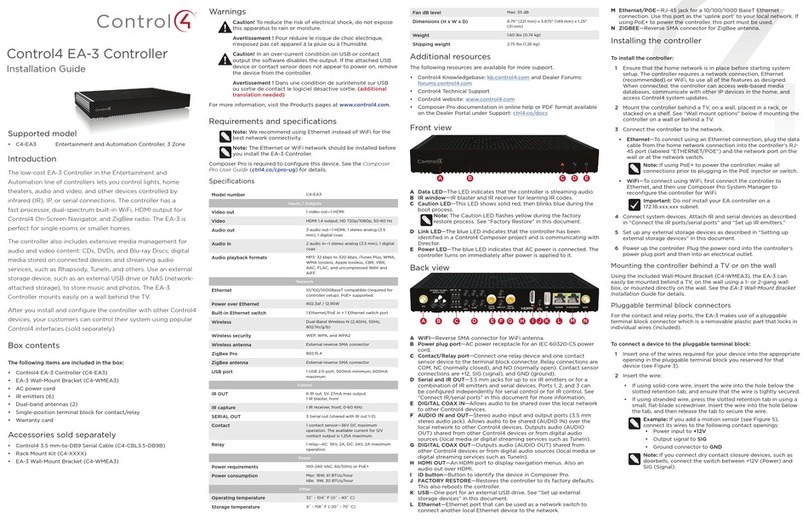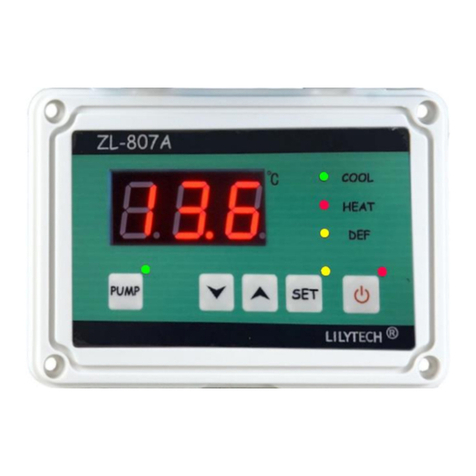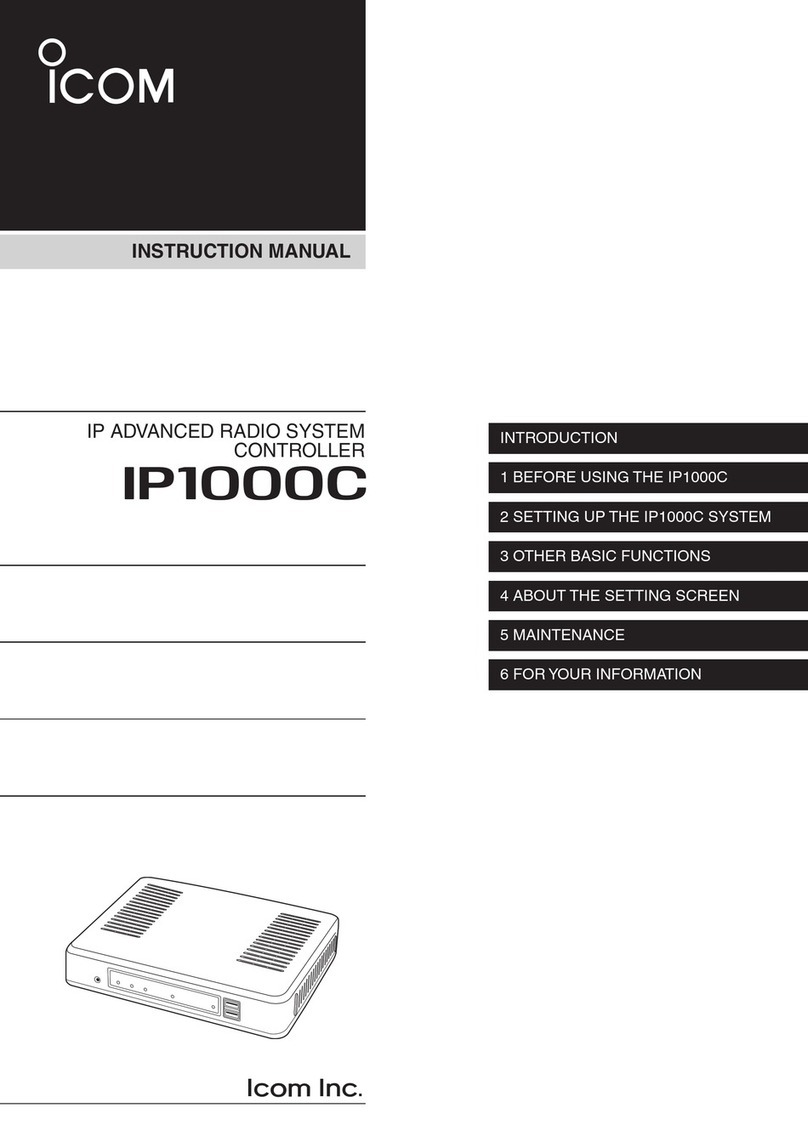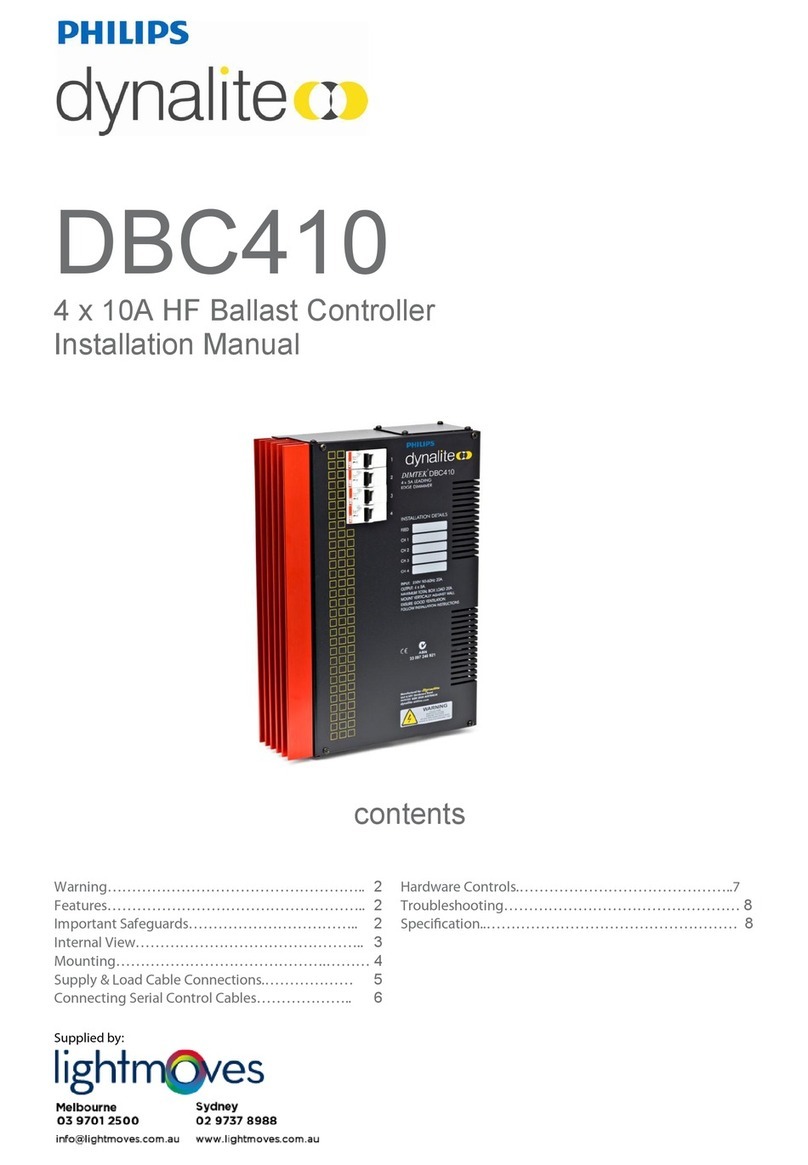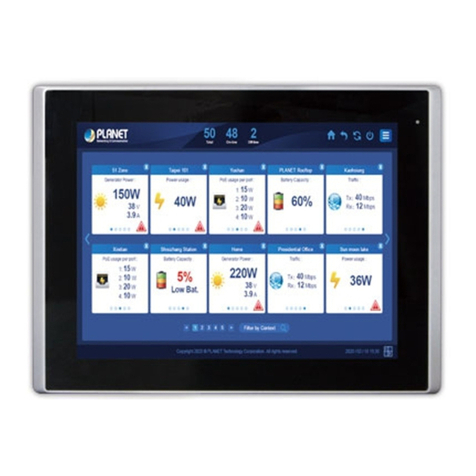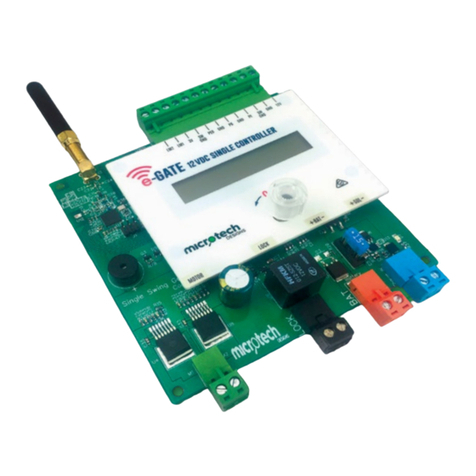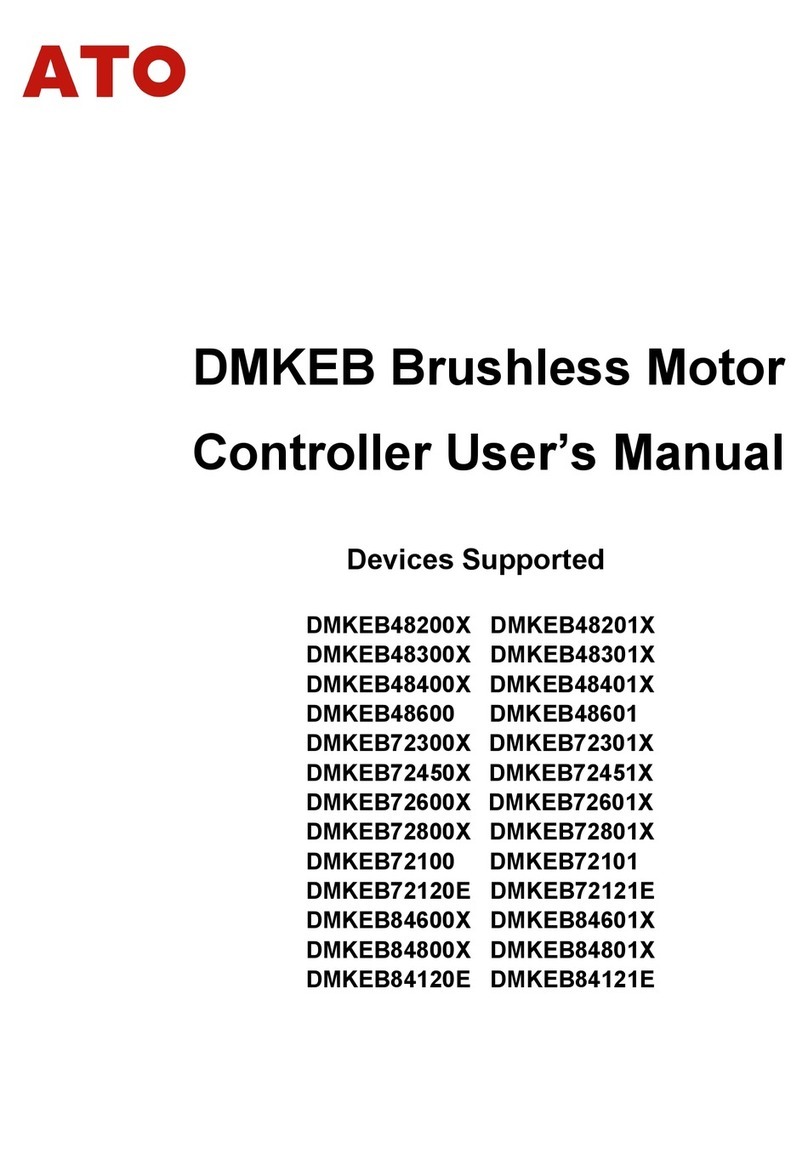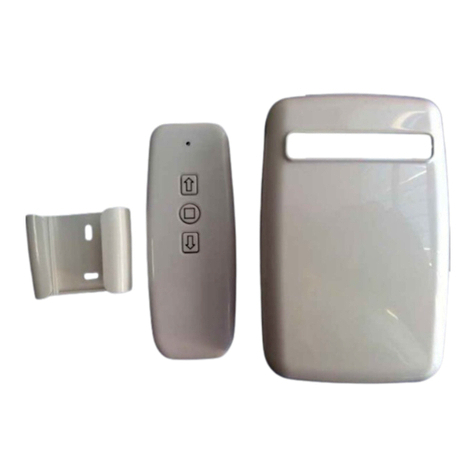Metek TWRF1 SCR Series Operation and maintenance manual

SCR POWER CONTROLLER
for RF Applications
Instruction, Operation and
Maintenance Manual
Number: 9100051
Revision 2
530 Lakeview Plaza Blvd, Ste C
Worthington, Ohio, USA 43085
Toll F re e : 1 - 8 88- PWR- C NTL (7 9 7 -26 85)
Ph o n e: 61 4 -3 0 8-550 0
Fa x : 614 - 3 08 - 5506
Web: w w w .hd rpow e r. c o m
TWRF1 SCR Series
30-225 Amperes
Single-phase
Phase-fired

This manual applies to all Model TWRF1 SCR Power Controls. Former TWRF1 manual – 9100026 has been
replaced with this manual.
For the support representative nearest you, please call Ametek HDR Power Systems main office at (614)-308-
5500.
Revision 1 December 2017 Initial Release
Revision 2 Aug 2022 General Revision
2022 by Ametek HDR Power Systems. No portion of this document may be reproduced either mechanically or electronically without the
prior consent of Ametek HDR Power Systems.

TWRF1 SCR Power Controller Table of Contents
Rev 2 Ametek HDR Power Systems i
TABLE OF CONTENTS
IMPORTANT SAFETY INSTRUCTIONS ............................................................................................................. 1
CHAPTER 1 - DESCRIPTION .............................................................................................................................. 3
1.1 General Description 3
1.2 Application 3
1.3 Operation 3
1.4 Selecting the Proper Rated Power Controller 3
1.5 Specification 4
1.6 Option ER (Extended Ramp) 4
1.7 Additional Options 4
CHAPTER 2 - INSTALLATION ............................................................................................................................ 7
2.1 Mounting the TWRF1 7
2.2 Input/Output Wiring 7
2.3 Fan Wiring (applicable to models rated 90 A and higher) 7
2.4 Wiring Overtemperature Contacts 8
2.5 Command Signal Input 8
2.6 Determining Line Frequency 9
2.7 Voltage Changeover 9
CHAPTER 3 - OPERATION ............................................................................................................................... 11
3.1 General 11
3.2 Front Panel Indicators 11
3.3 Remote Manual Control with a Potentiometer 11
3.4 Process Command Input Control 12
3.5 Auto/Manual Control with a Controller and Remote Potentiometer 13
3.6 On/Off Control 14
3.7 Shutdown 14
3.8 Overcurrent Trip 15
CHAPTER 4 - THEORY...................................................................................................................................... 17
4.1 Functional Description 17
4.2 Overview of the TWRF1 17
4.3 Digital Firing Control Circuit 17
4.4 Pulse-Train Firing 17
4.5 Phase-Lock Loop 17
4.6 SPAN and ZERO Controls 18
4.7 Voltage-Squared Feedback 18
4.8 Shut-down 18
CHAPTER 5 – TROUBLESHOOTING ............................................................................................................... 19
5.1 Customer-Service Program 19
5.2 Troubleshooting Typical Symptoms 19
5.3 Static Precautions when Servicing 19
5.4 Environmental Problems 20
5.5 Input Power and Load Connections 20
5.6 Correcting Troubles in the TWRF1 Itself 21
CHAPTER 6 - SERVICE ..................................................................................................................................... 22
6.1 Communication Procedures 22
6.2 Spare Parts Orders – Routine or Emergency 22
6.3 Spare Parts List 23
CHAPTER 7 – WARRANTY POLICY ................................................................................................................ 24

Table of Contents TWRF1 SCR Power Controller
ii Ametek HDR Power Systems Rev 2
7.1 Warranty 24
7.2 In-house Repair Services 24
7.3 Field Service Repairs 25
APPENDIX .......................................................................................................................................................... 26
Appendix A – System Schematic 26
Appendix B – 30-60 A Outline 27
Appendix C – 90-225 A Outline 28

TWRF1 SCR Power Controller Table of Contents
Rev 2 Ametek HDR Power Systems iii
TABLE OF CONTENTS
Par. Title Page
ILLUSTRATIONS
Figure 2.1 Thermostat Connections ..................................................................................................................... 8
Figure 2.2 Isolated/Non-Isolated Switches .......................................................................................................... 8
Figure 2.3 T1 Transformer Connections .............................................................................................................. 9
Figure 3.1 Control Panel .................................................................................................................................... 11
Figure 3.2 Remote Control with a Potentiometer ............................................................................................... 12
Figure 3.3 Process Controller Input Connections .............................................................................................. 13
Figure 3.4 Auto/Man Control with Controller and Remote Potentiometer ......................................................... 13
Figure 3.5 On/Off Control ................................................................................................................................... 14
Figure 3.6 Shutdown Control ............................................................................................................................. 14
Figure 3.7 Current Limit/Trip Board ................................................................................................................... 15
Figure 4.1 AC Switch and SCR On-time ............................................................................................................ 17
TABLES
Table 1.1 kVA vs. Impedance .............................................................................................................................. 4
Table 1.2 TWRF1 Model Number Breakdown ..................................................................................................... 4
Table 1.3 General Specifications of TWRF1 Models ........................................................................................... 5
Table 2.1 Wire Size Information ........................................................................................................................... 7
Table 2.2 Transformer Voltage Wiring ................................................................................................................. 9
Table 5.1 Troubleshooting Chart (Symptoms and Solutions) ............................................................................ 21
Table 6.2 Torque Specifications ........................................................................................................................ 21
Table 6.1 TWRF1 Spare Parts List .................................................................................................................... 23

Table of Contents TWRF1 SCR Power Controller
iv Ametek HDR Power Systems Rev 2

TWRF1 SCR Power Controller Safety Instructions
Rev 2 Ametek HDR Power Systems 1
SAVE THESE INSTRUCTIONS
IMPORTANT SAFETY INSTRUCTIONS
WARNING
Observe all warnings and cautions in this manual. Failure to do so may result in serious injury or death.
Refer all service to properly trained and qualified service personnel. Never work alone.
Lethal voltages exist on exposed heat sinks even if the power controller is turned off. Remove power and lock
out power before attempting any service.
This manual contains important safety instructions that must be followed during the installation and
maintenance of the SCR Power controller. Read this manual thoroughly before attempting to operate this
Power controller.
An appropriate branch circuit fused disconnect or circuit breaker with this Power Controller is required to
ensure the safety of operating personnel.
CAUTION
HAZARDOUS VOLTAGES exist at the Power Controller Load, AT ALL TIMES, when input voltage is
connected. This condition exists even when the Power Controller is set to deliver zero output.
Printed circuit boards contain sensitive components that can be damaged by electrostatic discharge (ESD).
Observe precautions for handling electrostatic sensitive devices. Reference Maintenance and Troubleshooting
(Chapter 5) of this manual for details
In case of fire, use a dry chemical fire extinguisher to put out the fire. Using a liquid fire extinguisher may
cause electric shock.
The SCR Power Controller makes use of components dangerous for the environment (electronic printed circuit
boards, electronic components). The components removed must be taken to specialized collection and
disposal centers.

Safety Instructions TWRF1 SCR Power Controller
2 Ametek HDR Power Systems Rev 2

TWRF1 SCR Power Controller Description
Rev 2 Ametek HDR Power Systems 3
CHAPTER 1 - Description
1.1 General Description
The TWRF1 is a Single-phase, phase-fired power controller, and can operate with a wide variety of
input signals and line voltages up to 575 Vac and currents ranging from 30 through 225 amperes. The
TWRF1’s output voltage is proportional to its input signal, with the output voltage regulated to +1%
with a +10% line voltage change. The TWRF1 features pulse-train firing which provides high immunity
to possible SCR firing disturbances, and phase-lock loop circuitry which ensures line frequency
synchronization. Other features are input isolation from ground, soft-start, and automatic restart
circuitry. A customer provided potentiometer controls to the Command signal. A variety of other
external control methods are available, more detailed description of the features mentioned above is
provided in Chapter 3 of this manual.
1.2 Application
Phase-Fired SCR Power Controllers provide infinitely variable firing angles for precise control of
single-phase power to resistive or inductive loads. This precise control is essential for transformer
coupled loads or loads with great resistance changes due to temperature or start-up. Phase-Fired
units may also be used on straight resistive loads as well, but the lower power factor and higher
harmonics may present a problem to other equipment mounted nearby. A zero fired model would be a
better choice.
1.3 Operation
The TWRF1 accomplishes power control by the switching action of a pair of inverse-parallel power
SCRs. The switching, or gating, of the SCRs is controlled by a digital firing control circuit synchronized
“in phase” with line frequency (either 50 or 60 Hz). A soft-start (approximately a 1 cycle ramp) feature
is standard that allows the Power Controller to fire into the primary of a transformer or to control power
to heating elements which have a large resistance change during start-up. The output may be adjusted
by the on-board multi-turn potentiometers or by a voltage or current signal from a process controller.
ZERO and SPAN controls allow the user to calibrate the SCR unit's output to the process command
signal. Terminals are available for connection of a remote manual potentiometer.
An overcurrent trip is included. This circuit protects from output current overloads by serving as a fast-
gate shutdown (similar to an electronic fuse.) Trip point is adjustable from 30% to 200% of the SCR
Power Control’s current transformer rating. When the peak current level exceeds the preset trip level,
SCRs are gated off, and the load current is shut down within 1/2 cycle. A form C relay output is
provided.
The overcurrent trip includes a Form C relay output and provisions for a remote overcurrent reset push
button. The relay output terminals for the TWRF1 are 35 and 36 for the N.C. and 36 and 37 for the
N.O. The remote reset PB connects to terminals 33 and 34. Reference Figure 3.7.
1.4 Selecting the Proper Rated Power Controller
Use the Table below to select the proper sized TWRF1. You will need the incoming line voltage and
the transformer leakage impedance. For voltages other than 480V, ratio the incoming voltage using
the 480V chart provided below. For example, a 240V system the kVA would be half that on the chart
for any given kVA. The kVA is based upon the one cycle surge ratings of the SCRs installed in each
of the power controls.

Description TWRF1 SCR Power Controller
4 Ametek HDR Power Systems Rev 2
Table 1.1 kVA vs. Impedance
Impedance
Current Rating 4% 6% 8% 10% 12%
kVA
30 Amps 9 13 17 22 30
40 Amps 9 13 17 22 30
60 Amps 9 13 17 22 30
120 Amps 19 32 40 54 60
225 Amps 37 57 95 107 120
1.5 Specification
Specifications for the TWRF1 SCR power controller are given in Tables 1.1 and 1.2.
Table 1.2 TWRF1 Model Number Breakdown
TWRF1 – 480 – 120 – NO – ER – 01
NOTE: N.C. Thermostat is included in current ratings above 60 A.
1.6 Option ER (Extended Ramp)
The options limits the rate at which the output can increase to prevent high inrush currents with
transformer coupled loads or high cold-to-hot resistance ratios such as tungsten heating elements
The rate of increase is limited to approximately 100% over four seconds. The standard extended ramp
time is 12 cycles.
1.7 Additional Options
The options described above are the ones most commonly used. Additional options are available. For
more information, contact Ametek HDR Power Systems.
120 Vac - 120
240 Vac - 240
400 Vac - 400
480 Vac - 480
575 Vac -
575
30 A rms - 30
40 A rms - 40
60 A rms - 60
90 A rms - 90
120 A rms – 120
225 A rms – 225
N.O. Thermostat - NO
N.C. Thermostat - NC
Extended Ramp - ER
Can have multiple selections
4-20 mA - 01
0-10 Vdc - 02
0-5 Vdc - 03
Auto/Man - 04
Manual Pot input - 05
Others
-
xx

TWRF1 SCR Power Controller Description
Rev 2 Ametek HDR Power Systems 5
Table 1.3 General Specifications of TWRF1 Models
Input line voltage: * 120, 240, 400, 480, or 575 Vac,
+10%, -15%, Single-phase
Line frequency: * 50 or 60 Hz
Current rating:
*
As indicated by model number (refer to Table 1.2)
Thermostat contact rating: 120 Vac, 5 A; resistive
Input Signal:
Non-isolated
Isolated
0 to 1.5 V (min); 0 to 10 V (max) - Standard
0 to 6 mA (min); 0 to 20 mA (max)
Control methods: 1. Potentiometer, 5 kΩ, 1/2 watt (Customer-supplied) - Standard
2. Dry contact closure (customer-supplied).
3. Temperature or process controller
*
*
Control signal input impedance:
Non-isolated input
Isolated input
1500 Ω
500 Ω
Control signal isolation:
From SCRs 2,500 Vac
From ac power input lines 2,500 Vac
From chassis 500 Vac
Power output:
Voltage regulation Voltage Squared
Power output linearity versus
control signals input
+2% (Non-isolated)
+5% (Isolated)
Power SCRs protection:
Current surge Subcycle I² T semiconductor fuse. – OPTIONAL
Transient voltage spikes (dv/dt)
Metal Oxide Varistor (MOV) and R-C snubber across each SCR pair; all
SCRs have PIV rating of 1,400 V.
Miscellaneous:
Phase-firing timebase 0º to 180º conduction per SCR
Controls: ZERO and SPAN potentiometers; 10-turn, screwdriver-adjustable.
Ambient Temperature range:
Environment 32 ºF to 122 ºF ( 0 ºC to 50 ºC) surrounding air
Pollution degree 2
Overvoltage Category III
Storage 14 ºF to 158 ºF ( -10 ºC to 70 ºC)
Weight per unit: Current Rating
30 through 60 A
90 through 225 A
lbs
6
18
kg
2.7
8.2
Outline and mounting: See appropriate drawing in Appendix
* Specify with order
** If you will be using temperature/process controller, specify its output; e.g., 4-20 mA, 0-10 Vdc, 2-10 Vdc,
etc. with your order.
NOTE: The TWRF1 should be tested or operated with an adequate load since an open output will have line
voltage at the load connections.

Description TWRF1 SCR Power Controller
6 Ametek HDR Power Systems Rev 2

TWRF1 SCR Power Controller Installation
Rev 2 Ametek HDR Power Systems 7
CHAPTER 2 - Installation
2.1 Mounting the TWRF1
Determine the voltage and current ratings from the nameplate of the unit (refer to Table 1.2). Then
determine space and mounting hole requirements by referring to the outline drawing (at the Appendix)
that applies to your model’s current rating. Mount the unit so the line and load connections are at the
top and ensure that upward airflow over the heat sink fins is unrestricted. On high current models,
allow adequate clearance for routing the relatively large diameter input and output lines.
2.2 Input/Output Wiring
Using appropriately sized and insulated conductors for the voltage and current ratings of your model,
make connections as shown in Appendix A. (Refer to Table 2.1 for wire size information). Torque
specifications of bolted connections can be found in Table 5.2.
A ground wire is required for proper operation. Use a 14 AWG for 15-30 A and 10 AWG or larger wire
for the other sizes.
NOTICE
Use copper conductors rated 75 ºC minimum for all model current ratings.
On the “internal” side of the TWRF1, the wire from L2 should connect to the appropriate tap of
transformer T1, depending on the line voltage to be used. Check the T1 connection by opening the
TWRF1 cover; T1 terminal voltages are clearly marked. Reference Chapter 2.7.
Table 2.1 Wire Size Information
Model Size Wire/Cable
30 A 8 to 0 AWG
40 A 8 to 0 AWG
60A 8 to 0 AWG
90 A 8 to 0 AWG
120 A 8 to 0 AWG
225 A 6 to 250 MCM
2.3 Fan Wiring (applicable to models rated 90 A and higher)
TWRF1 models rated 90 A and higher with cooling fans require 120 Vac power which must be
supplied by the customer. Fan power should be connected to terminals 21 and 22 as shown in Figure
2.1. Refer to Table 1.3 for fan power requirements by model.
The RF3 terminals available for the 120 Vac fan connections are shown Figure 2.1 and in the
schematic in Appendix A. Optional 220 Vac fans are available.
WARNING
Branch circuit overcurrent protection required is to be provided in
accordance with the national and local codes of the inspecting authority.

Installation TWRF1 SCR Power Controller
8 Ametek HDR Power Systems Rev 2
2.4 Wiring Overtemperature Contacts
Normally-closed (N.C.) heat sink thermostats are standard on all fan-cooled models (rated 90 A and
higher). These thermostats, which close on high heat sink temperature (200 ºF), may be used to
initiate an alarm, shunt trip, or other device for SCR protection. Thermostat connections are on
terminals 23 and 24 as shown in Figure 2.1.
If desired, normally-open (N.O.) contacts may be substituted for the normally-closed (standard). Heat
sink thermostats are optional on units with current ratings lower than 60 amperes and can be ordered
with either N.O. or N.C. contacts.
FAN POWER
120 Vac
(220 Vac
OPTIONAL)
OVER TEMP
N.O. STANDARD
(N.C. OPTIONAL)
21 22 23 24
Figure 2.1 Thermostat Connections
2.5 Command Signal Input
HDR’s TWRF Phase-Fired SCR Power Controllers are configured for a potentiometer (non-isolated)
but, has the capability of having either an isolated current or non-isolated voltage Command Signal
input. The standard input impedance is 500 ohms for isolated and 1500 ohms for non-isolated. The
potentiometer may by 500 Ω to 5 kΩ, and should be rated at 1/2 watt, minimum.
All units are equipped with DIP switches, select “isolated” position for a 4-20 mA command signal and
“non-isolated” for a voltage input such as 0-10 V dc. See Figure 2.2.
The isolated input works best with an offset Command Signal such as 4-20 mA; however, it will work
with both offset and zero based Command Signals. Zero based Command Signals may have a small
amount of non-linearity (input to output) at the low end. This should not be a problem on closed loop
systems.
Current Input Voltage / Manual Pot Input
Figure 2.2 Isolated/Non-Isolated Switches
----OPEN ----
12 3 4C1
C2
NON-ISOLATED-C2
SW2
ISOLATED-C1
SW1

TWRF1 SCR Power Controller Installation
Rev 2 Ametek HDR Power Systems 9
2.6 Determining Line Frequency
The TWRF1 is designed to operate on either 50 or 60 Hz. Usually the TWRF1 is shipped for 60 Hz
operation, unless otherwise ordered. The TWRF1 can be set for either ac line frequency by selecting
50 Hz or 60 Hz on SW3 on the control board on the inside front door.
2.7 Voltage Changeover
On occasion, customers may wish to operate a TWRF1 SCR Power Controller on line voltages other
than what was specified when originally ordered. The TWRF1 may be changed to accept a wide
range of line voltages (120, 240, 400, 480, 575 Vac), so long as the load current does not exceed the
TWRF1’s current rating. This is accomplished by performing the procedure described below.
.
Using the system schematic (located in the Appendix) as reference, perform the voltage changeover
procedure as follows.
1. Open the SCR power controller, and locate transformer T1. The primary side of T1 transformer
will contain two wires (one black, the other white and black). Refer to figure 2.3.
Figure 2.3 T1 Transformer Connections
2. Unsolder the Black/White wire on T1 from the voltage tap, and resolder it to the tap desired, as
shown in Table 2.2. Route the wires so that they are physically located under the transformer
terminals.
Table 2.2 Transformer Voltage Wiring
Desired Voltage T1 White &
Black Wire to
120 120
208, 220, 240 240
380, 400, 415 400
480 480
575 575
3. Close the unit, and apply line power. The unit is now ready for operation on the line voltage
selected. It is a good idea to identify the unit with a label or tag, noting that TWRF1 has been
modified for line voltage other than what it was specified for. This may prevent accidental use on
an incorrect line voltage in the future.
WARNING
Voltage changeover should be performed by qualified personnel only.
Always remove power and properly lock out power to the unit before
attempting any service.

Operation TWRF1 SCR Power Controller
10 Ametek HDR Power Systems Rev 2

TWRF1 SCR Power Controller Operation
Rev 2 Ametek HDR Power Systems 11
CHAPTER 3 - Operation
3.1 General
This Chapter provides information necessary for proper setup and operation of various methods used
to control the TWRF1.
a. Front Panel indications
b. Command input control
c. Remote manual control with a potentiometer
d. Auto/manual control with a controller and potentiometer
e. On/off control
f. Shutdown
Figure 3.1 Control Panel
3.2 Front Panel Indicators
Control Power Indicator – A Red Light Emitting Diode (LED) located on the front cover of the unit
signals when the control power is present.
Command Signal Indicator - The Command Signal Indicator is a green Light Emitting Diode (LED)
located on the front cover of the unit. The brilliance of this LED will change with a current Command
Signal. The brilliance increases with an increased Command Signal and decreases with a decreased
Command Signal. The LED will not function with a voltage or manual input.
Blown Fuse Indicator - The Blown Fuse Indicator is a yellow Light Emitting Diode (LED) located on the
front cover of the unit. Switches on the fuse controls the LED. Not available on 15-40 A models
3.3 Remote Manual Control with a Potentiometer
The TWRF1 is calibrated at the Factory for the specified input type and normally does NOT need
adjustment. However, should a setup be required use the following methods. Refer to chapter 2.5 for
the Command signal input configuration.

Operation TWRF1 SCR Power Controller
12 Ametek HDR Power Systems Rev 2
a. With the power to the TWRF1 turned off, connect the potentiometer as shown in Figure 3.3. The
CW position is the full power output position. Terminal TB1-5 is internally connected to a positive
dc voltage source.
Figure 3.2 Remote Control with a Potentiometer
b. Connect a voltmeter across terminals X1 and X2 of the TWRF1. Set the voltmeter range to
measure the full output voltage.
c. Set the SPAN control and remote potentiometer fully CCW.
d. Close the fused disconnect or circuit breaker to apply power to the TWRF1. The unit should be
energized, with no output.
e. Adjust the ZERO control CW until the output just turns on, then turn the ZERO control CCW just to
the point where the output voltage reading is zero.
f. Set the SPAN control and remote potentiometer fully CW. The output should be full-on.
g. Observe the voltmeter and slowly adjust the SPAN control CCW, just to the point where the output
voltage reading is at maximum.
h. If necessary, readjust ZERO with remote potentiometer fully CCW and SPAN control and remote
potentiometer fully CW.
i. Turn off the line power to the TWRF1 and disconnect the test equipment.
3.4 Process Command Input Control
Some applications require a closed loop input from a process controller. Should an isolated setup be
required use the following methods. Refer to chapter 2.5 for the Command signal input configuration.
a. Set the ZERO and SPAN controls fully CCW (counterclockwise).
b. Connect a voltmeter across terminals X1 and X2 of the TWRF1. Set the voltmeter range to
measure full input voltage.
c. Close the fused disconnect or circuit breaker to apply power to the TWRF1. Turn the front panel
CUR/PWR potentiometer fully CW. If an isolated signal is used turn the Process controller on and
set to demand zero power output.
WARNING - ELECTRIC SHOCK CAN KILL
HAZARDOUS VOLTAGES exist at the output terminals and at the load when
the input voltage is connected. This condition exists even when the Controller is
set to deliver zero output. Always remove power and properly lock out power to
the unit before attempting any service, including the load.

TWRF1 SCR Power Controller Operation
Rev 2 Ametek HDR Power Systems 13
Figure 3.3 Process Controller Input Connections
d. Adjust the ZERO control CW until the output just turns on, then turn the ZERO control CCW just to
the point where the output voltage reading is zero.
e. Set the CUR/PWR potentiometer or Process controller to demand 100% output. Observing the
voltmeter, adjust SPAN CW just to the point where the reading is below the maximum output
voltage. Then adjust SPAN CW just to the point where the meter reading is at maximum.
f. Repeat steps 3.3e and 3.3f as necessary, to ensure proper control adjustments have been made.
g. Turn off the line power to the TWRF1 and disconnect the test equipment. The TWRF1 is now
ready for automatic operation.
h. Adjust the CUR/PWR potentiometer CW until the output trips to the desired level.
3.5 Auto/Manual Control with a Controller and Remote Potentiometer
On closed loop processes it may be desirable to be able to operate the unit manually. The SCR Power
Controller has this capability designed into it. Connect the Command Signal, a Remote Manual control
and an Auto/Manual switch in the Auto position. By switching to the Manual position, the Remote
Manual control operates and the auto signal is disconnected.
With the power to the TWRF1 turned off, connect the switch, potentiometer, and controller as shown in
Figure 3.4 and remove jumper from terminal TB1-7 and TB1-8. Install the AUTO/MAN switch in the
same general location as the remote manual potentiometer. Note that the full CW position of the
potentiometer is the full-power-output position.
Figure 3.4 Auto/Man Control with Controller and Remote Potentiometer
Place the AUTO/MAN switch to AUTO and calibrate the system as described in steps 3.3b through
3.3h.

Operation TWRF1 SCR Power Controller
14 Ametek HDR Power Systems Rev 2
3.6 On/Off Control
Some applications require that a simple ON/OFF type control be used. The unit can be used in these
simple applications. It can be connected for turn on by a contact closure.
With the TWRF1 configured for non-isolated inputs and the power to the TWRF1 turned off, connect
the system as shown in figure 3.5. A closed contact will turn on (enable) the TWRF1.
Figure 3.5 On/Off Control
Calibrate the system by performing the steps in 3.3. Note that zero power demand is accomplished by
opening the contacts with the controller, and maximum power demand is present when the contacts
are closed.
3.7 Shutdown
When it is necessary to shutdown or disable the output, it is a simple matter. Connect a dry contact
closure between terminals 3 and 4 of the firing circuit as shown in Figure 3.6. A closed contact will
disable the TWRF1 output.
Figure 3.6 Shutdown Control
(Output Disabled By Contact Closure)
WARNING
This method of control is not to be used with isolated inputs!
Table of contents
Popular Controllers manuals by other brands
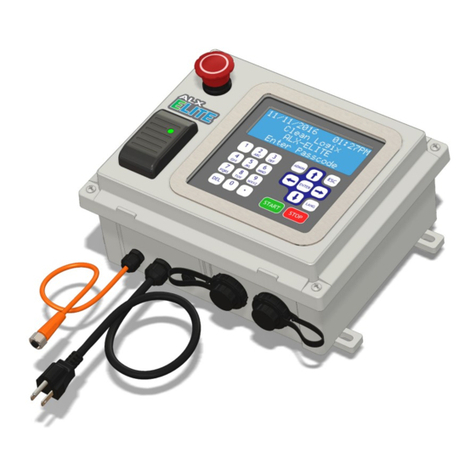
Clean Logix
Clean Logix ALX-ELITE user manual
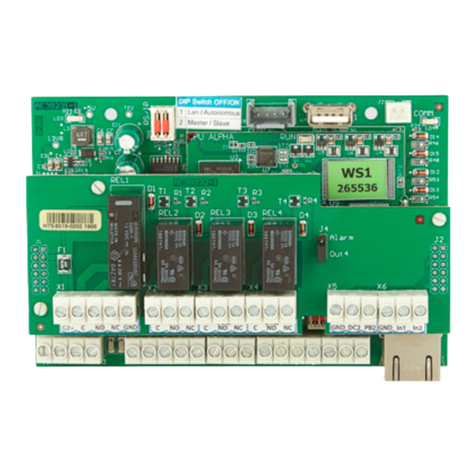
XPR Access
XPR Access WS4-1D quick start guide
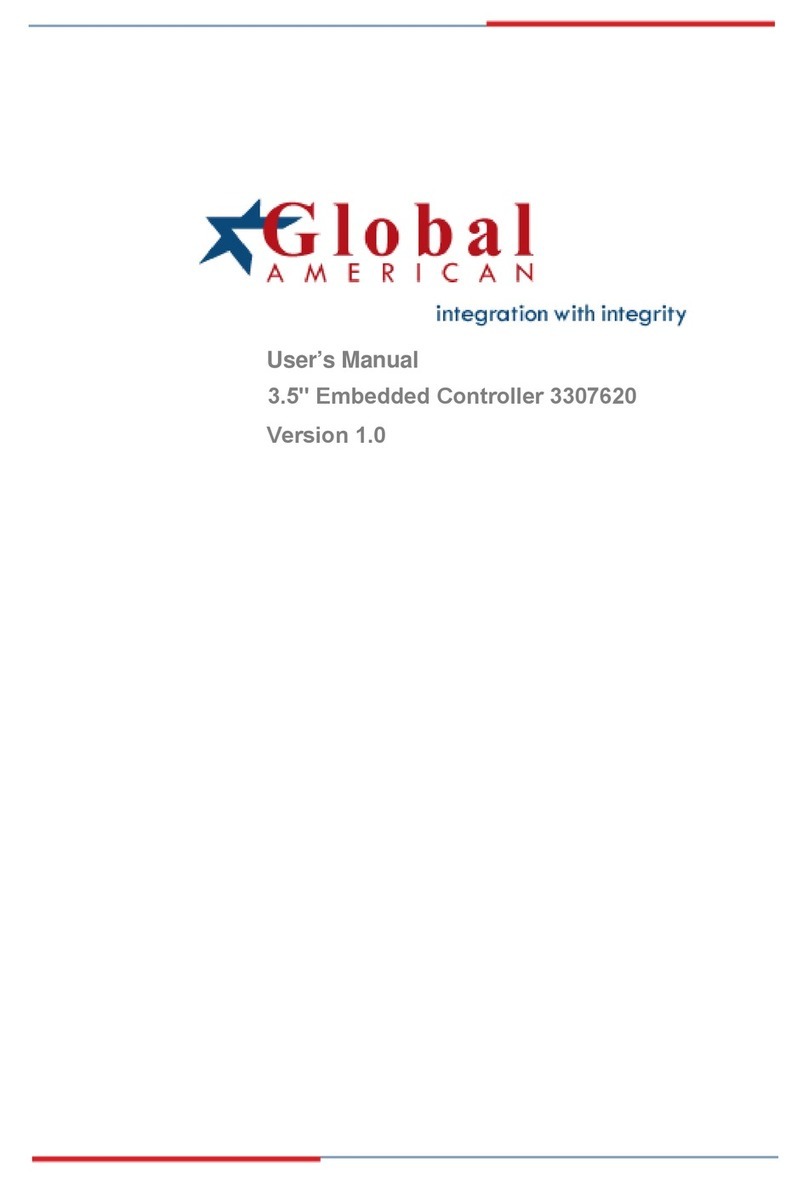
Global American Inc.
Global American Inc. 3307620 Version 1.0 user manual
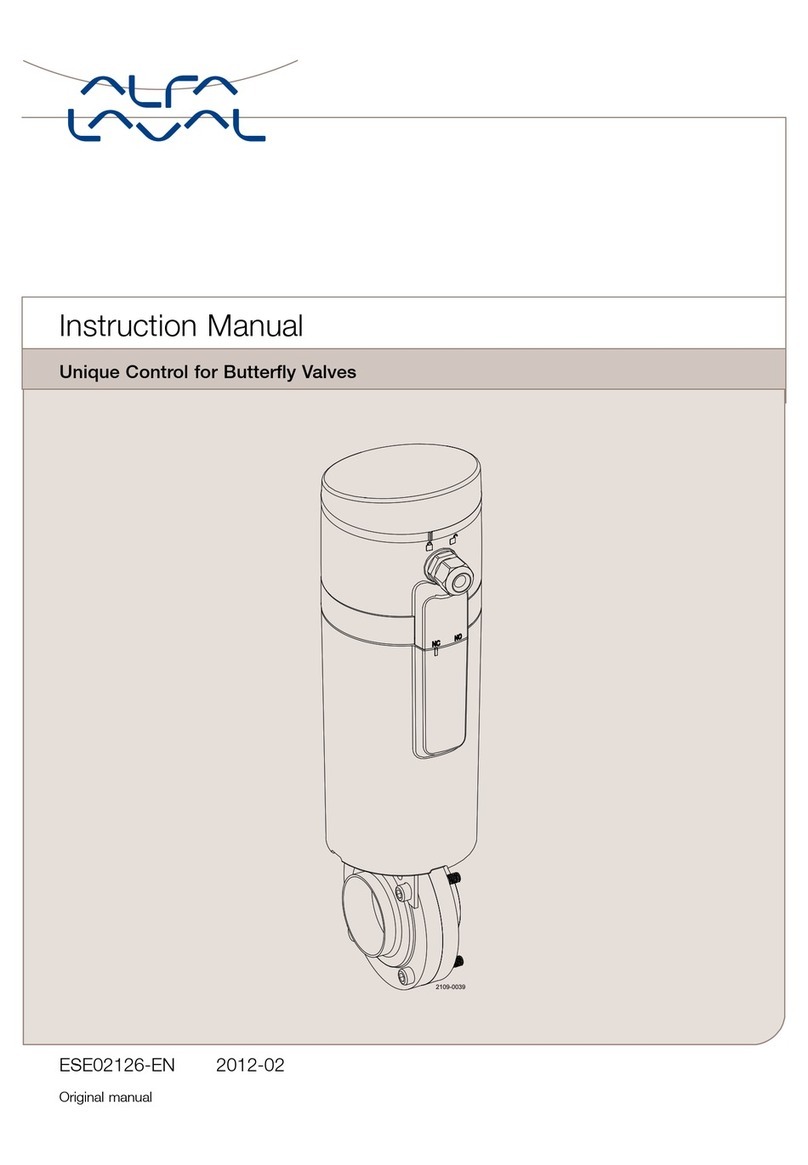
Alfalaval
Alfalaval ESE02126-EN instruction manual

BZB Gear
BZB Gear BG-UHD-VWP-1X4 user manual

HANYOUNG NUX
HANYOUNG NUX HY Series instruction manual
